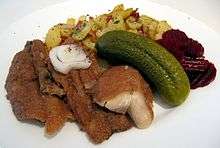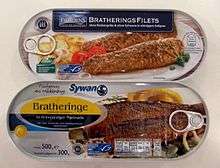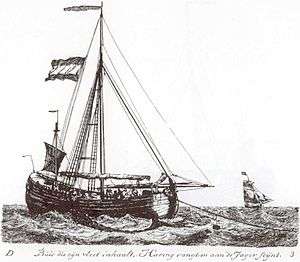Brathering

Brathering (/ˈbrɑːtˌheɪrɪŋ/ ![]() listen ; English: ″fried herring″) is a simple and traditional German dish of fried, marinated herring. It is typical for the cuisine in northern Germany either for lunch or as a snack at fast food stands or take-out restaurants.[1]
listen ; English: ″fried herring″) is a simple and traditional German dish of fried, marinated herring. It is typical for the cuisine in northern Germany either for lunch or as a snack at fast food stands or take-out restaurants.[1]
Preparation of the herrings

Usually, the green (i.e., fresh) herrings with the heads and guts removed are either breaded or simply turned in flour, then fried, and finally pickled in a marinade of white vinegar and briefly boiled water, onion, salt, spices like pepper, bay leaves, mustard seeds, and a little sugar. The thin bones of the green herring are partially dissolved in the marinade, so that they hardly interfere with eating.[2]
If refrigerated, fried herrings may be preserved for up to two weeks. Brathering is also available as a commercial product in cans.
Typical servings
Brathering itself is served well pervaded and cold, together with warm fried potatoes (Bratkartoffeln) or cold potato salad (Kartoffelsalat).[3]
Sometimes, Brathering is also offered as part of fish sandwiches (Fischbrötchen).
Trivia
- Martin Luther once stated that Brathering served with cooked green peas and mustard (an unknown combination nowadays) was one of his favorite dishes.[4]
- The dish Brathering was mentioned in the diary novel Lieber Niels by author Matthias Zschokke and criticised in it as "a weird recipe", for being "old fashioned" and tasting like mud.[5]
Literature
| Wikimedia Commons has media related to Brathering. |
- Koios, Eloi Rylan (2011): Brathering. List of Raw Fish Dishes, Fish (Food), and Seafood. TRACT. ISBN 978-613-8-59305-8.
- Organisation for Economic Co-Operation and Development (2009) Multilingual Dictionary of Fish and Fish Products Page 147, John Wiley & Sons. ISBN 978-140-5-15760-5.
References
- ↑ Zipner, Helmut (2002): Kulinarischer Norden. Rezepte von Profiköchen und Publikum. Schlütersche. ISBN 9783877068595. Page 23.
- ↑ Sälzer, Sabine (1998): Die echte deutsche Küche. Gräfe und Unzer. ISBN 9783774215382.
- ↑ Hering, Richard and Walter Bickel (Ed.) (1978): Herings Lexikon der Küche. Fachbuchverlag Pfanneberg. Gießen. ISBN 3-8057-0218-3. Page 194.
- ↑ Kawerau, Gustav (1903): Martin Luther, Sein Leben und Seine Schriften. Duncker. Page 497.
- ↑ Zschokke, Matthias (2011): Lieber Niels. Wallstein. ISBN 9783835309098. Page 451.

